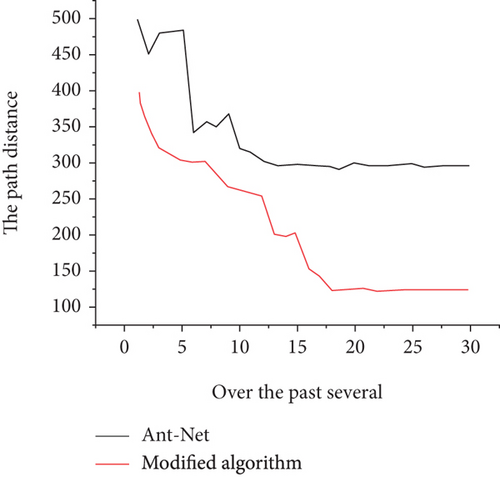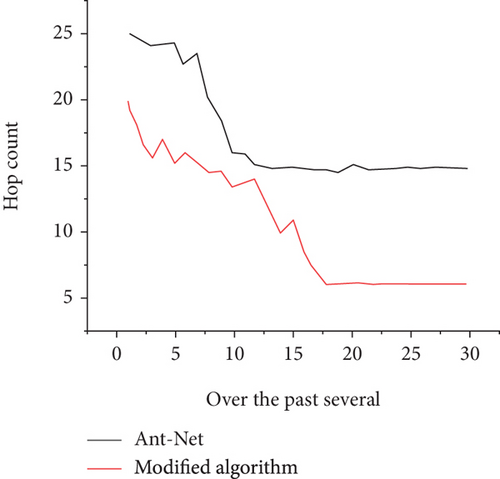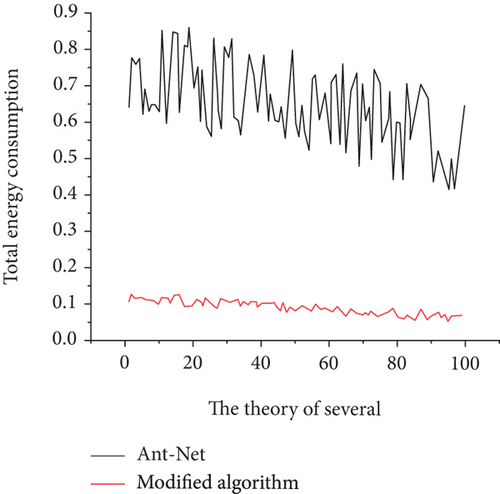[Retracted] Research on Communication Optimization of Power Carrier Sensor Control Network Based on Ant Colony Algorithm
Abstract
In order to optimize the communication research of dynamic carrier sensing control network based on ant colony algorithm, this paper proposes an improved ant colony routing algorithm. Firstly, this paper establishes the experimental model, sets up the relevant experimental parameters, and builds the MATLAB experimental platform. The simulation results show that compared with the basic ant colony algorithm, the improved algorithm performs better in the final jumps. The average residual energy of the sensor node is more. The total energy consumption is less, and the consumption in each round is relatively stable. The residual energy fluctuation range of the sensor node is small, and the energy consumption of each node is relatively balanced. Therefore, the improved ant colony algorithm is important for improving the survival cycle of the WSN. The algorithm comprehensively considers the factors such as convergence speed, node communication distance, node residual energy, and optimal solution and can finally find the path with low node energy consumption and high node residual energy.
1. Introduction
As an effective method to solve the “last kilometer” communication problem, power line carrier communication is being concerned and studied by more and more scientific and technological workers. It is a communication mode with great development potential [1]. There are trial examples in street lamp monitoring system, remote automatic meter reading system, community intelligent control, and management system [2]. However, power network is a special network for power transmission. When it is used as a communication network, the communication characteristics of the network will become very complex [3]. This complexity is reflected in the complex physical topology of the network. The topology of low-voltage distribution network is very complex, and sometimes, there are great differences in different distribution places [4]. For example, in the street lamp system, the network topology is a typical star structure. In residential buildings, the network topology is a tree structure, and the topology of a single place may become more irregular [5]. Time variability of communication channel, for carrier signal, low-voltage power line is a nonuniform distribution transmission line. At any location in the low-voltage distribution network, various power loads with different properties are randomly input and disconnected, which makes the channel show strong time variability [6]. The frequency selective load of communication channel varies greatly due to the miscellaneous load in low voltage distribution network. [7], large load variation, many and strong noise types, and mismatched impedance of each node, the carrier signal is easy to produce reflection, standing wave, resonance, and other phenomena, which makes the attenuation of the signal extremely complex, resulting in strong frequency selectivity of the power line channel [8]. Aiming at this research problem, An and Weber published a series of papers on the channel characteristics of power line and analyzed in detail the impedance spectrum and attenuation spectrum of 10 kV high-voltage power line at medium and high frequencies. These basic studies provide a basis for the design of low-voltage power line communication system [9]. Rim and Kang proved the convergence of a simple ant colony algorithm [10]. Saffarian et al. analyzed the convergence of an adaptive ant colony algorithm and obtained the conditions for the global convergence of the algorithm [11]. Based on the current research, this paper proposes an improved ant colony routing algorithm. The algorithm takes into account the factors such as convergence speed, node communication distance, node residual energy, and optimal solution. Finally, it can find the path with small node energy consumption and large node residual energy.
2. Method
2.1. Mechanism and Principle of Ant Colony Algorithm
Ant colony algorithm is actually an intelligent multiagent system. Due to its self-organization, ant colony algorithm does not have high requirements for the situation in the external environment. In essence, the self-organization mechanism can be understood as increasing the moisture content of the system without external action. Ant colony algorithm directly reflects the dynamic evolution from disorder to order [12].
The optimal solution of the combinatorial optimization problem can be obtained in this way. The ant colony algorithm determines the decision point through “exploration” and “utilization” combined with the pheromone and rebuilds the pheromone of the ant individual in the global according to the corresponding pheromone update law. Finally, the behavior direction of the ant colony activity is planned from the global perspective [13].
2.2. Mathematical Model of Basic Ant Colony Algorithm
In order to deeply understand the system model of ant colony, we first discuss a problem, traveling salesman problem (TSP). TSP can be expressed as follows: firstly, given n cities of the target, a traveler randomly selects a certain city a to start and is required to traverse all elements in n once (cannot be repeated) and finally return to a to find the shortest path [14].
Let G = (C, L) be a directed graph; TSP is to find a Hamilton cycle with the shortest length from G, which ensures that n city elements in C = {c1, c2, ⋯, cn} can only be traversed once [15].
For TSP with n urban elements, dij(i, j = 1, 2, ⋯, n), there are (n − 1)! /2 different selection paths mathematically. The best way to solve this kind of problem is to search a lot in the overall situation, but if the number n of cities is large, this method will become unrealistic, but ant colony algorithm will have a perfect solution.
Let bi(t) represent the number of ants at element I at time t, τij(t) represent the pheromone concentration at time t(i, j), n represent the scale of TSP, m represent the total number of ants and have ; Γ = {τij(t)|ci, cj ⊂ C} represents the set of concentrations of remaining pheromones on 1ij connected by two urban elements in time tC. At the initial time of the algorithm, the pheromone concentration on each optional path is the same; let τij(0) = const. Ant colony algorithm completes the optimization process through g = (C, L, Γ).
In equation (3), parameter dij represents the distance between two adjacent elements. As can be seen from equation (3), for individual K, the smaller the dij, the greater the ηij(t), and the greater the . Equation (3) intuitively reflects the expected degree of individual jumping from I to J.
In formula (4), ρ represents the volatilization coefficient of pheromone; (1 − ρ) represents the residual coefficient of pheromone, where ρ ⊂ [0, 1); Δτij(t) represents the increase of pheromone on (i, j) in this cycle; and Δτij(0) = 0 indicates the amount of pheromone left by the k-th ant on .
where Q represents the concentration of pheromone, which affects the convergence speed, and Lk represents the total path length traveled by the k-th ant in one traversal.
where dij represents the distance between any two adjacent urban elements.
Among the above three algorithm models, the second and third models adopt local information, and the ant updates the pheromone on the path immediately after each jump. The first model uses the overall information. When the individual traverses all the elements, it starts to update the pheromones on all paths. Therefore, this model is more conducive to the optimization of TSP problem. The first model is usually used when selecting the basic model of the algorithm.
2.3. WSN Routing Algorithm Based on Improved Ant Colony Algorithm
Each sensor in WSN is a node, which is equivalent to the urban element in the traditional ant colony algorithm. It transmits information from the source node to the destination node in the form of a single hop and requires the path distance to be as short as possible. This method is very similar to ant colony algorithm. Ants transfer from the source node to the destination node in some way, so ant colony algorithm can be used for routing optimization of wireless sensor networks. Ant colony algorithm is very suitable for routing in wireless sensor networks because of its parallelism. There have been articles at home and abroad that use the ant colony algorithm for WSN routing optimization, but it is difficult to take into account the remaining energy of the node and the communication distance of the node. If the node with less remaining energy or the node on the shortest path fails, it will affect the entire network lifespan.
For each node in the WSN, the ant colony algorithm can be used to search for the optimal path from the node to the sink node, and then, the obtained optimal path is stored in the routing table of the corresponding node. The routing table is sent to the next node together, and the next node can continue to forward the information to its next node according to the information in the routing table and so on until the target node.
For each node in the WSN, the ant colony algorithm can be used to search for the optimal path from the node to the sink node, and then, the obtained optimal path is stored in the routing table of the corresponding node. The routing table is sent to the next node together, and the next node can continue to forward the information to its next node according to the information in the routing table and so on until the target node.
- (1)
Energy consumption model
where α0, α,1, K is a constant, n is the number of traversals of the ant colony, and N is the total number of traversals. It can be seen that the larger n is, the smaller α(n) value is, so that the proportion of pheromone concentration can adapt to the change of traversal times.
- (2)
Pheromone update strategy
where C is a constant.
3. Results and Analysis
In order to verify the effectiveness of the algorithm, this paper only selects node a for verification. Figure 1 shows that the route distance between node A and sink node changes with the number of iterations. It can be seen that both algorithms can converge, but ant net algorithm is easier to fall into the local optimal solution. The improved algorithm has faster search speed at the beginning, and the convergence speed of the algorithm begins to slow down with the progress of traversal. In this way, it is more conducive to search the optimal solution in a wider space. The algorithm converges about the 18th time, because the weight of pheromone concentration of the improved algorithm changes according to a certain law.

Figure 2 shows that the number of hops of the path from source node a to sink node changes with the number of iterations. From the overall trend, when the number of iterations increases, the number of hops corresponding to the two algorithms decreases, but the final number of hops of the improved algorithm is better, because the improved algorithm generally does not fall into the local optimal solution, so it can find the global optimal solution.

Figure 3 shows the change of the total energy consumption of the node with the number of rounds. It can be clearly seen from the figure that the total energy consumption of the improved algorithm is less, and the consumption in each round is relatively stable. The improved algorithm comprehensively considers the directionality of the transmission and the distance of the sink node when selecting the next node to jump to, without causing too much waste of energy, but Ant-Net does not consider these factors, resulting in more energy consume.

Firstly, the behavior of ant colony is described, and then, the ant colony algorithm is described in detail from the mechanism and principle of ant colony algorithm, the basic mathematical model of ant colony algorithm, and the basic implementation process of ant colony algorithm. Then, the advantages and disadvantages of ant colony algorithm in WSN routing are objectively described, aiming at the problems of slow convergence speed and easy to fall into local optimal solution in the application of basic ant colony algorithm. An improved ant colony routing algorithm is proposed, which takes into account factors such as convergence speed, node communication distance, node residual energy, and optimal solution and finally can find a path with low node energy consumption and large node residual energy. The experimental results support the application of the proposed basic ant colony algorithm and improved ant colony algorithm in WSN routing. Firstly, the experimental model is drawn up, the relevant experimental parameters are set, and the MATLAB experimental platform is built. The simulation results show that compared with the basic ant colony algorithm, the improved algorithm performs better in the final number of hops; the average residual energy of sensor nodes is more; the total energy consumption of nodes is also less, and the consumption performance in each round is relatively stable. The residual energy fluctuation range of sensor nodes is small, and the energy consumption of each node is relatively balanced. Therefore, the improved ant colony algorithm is of great significance to improve the life cycle of WSN.
4. Conclusion
The Ant-Net algorithm is more likely to fall into the local optimal solution. The improved algorithm has a faster search speed at the beginning. As the traversal progresses, the convergence speed of the algorithm begins to slow down, which is more conducive to the search for the optimal algorithm in a wider space. Because the pheromone concentration weight of the improved algorithm changes according to a certain law, the algorithm converges around the 18th time. MATLAB simulation results show that the improved ant colony algorithm converges faster, makes the energy consumption of the network relatively balanced, and prolongs the whole network life cycle. Compared with the basic ant colony algorithm, the improved algorithm performs better in the final number of hops; the average residual energy of sensor nodes is more; the total energy consumption of nodes is also less, and the consumption performance in each round is relatively stable; the residual energy fluctuation range of sensor nodes is small, and the energy consumption of each node is relatively balanced. Since there may be a variety of interference factors in the real environment, the existence of these factors is quite different from the ideal environment used in this paper, so the actual application performance of the algorithm needs to be further verified.
Conflicts of Interest
The authors declare that they have no conflicts of interest.
Open Research
Data Availability
The data used to support the findings of this study are available from the corresponding author upon request.




